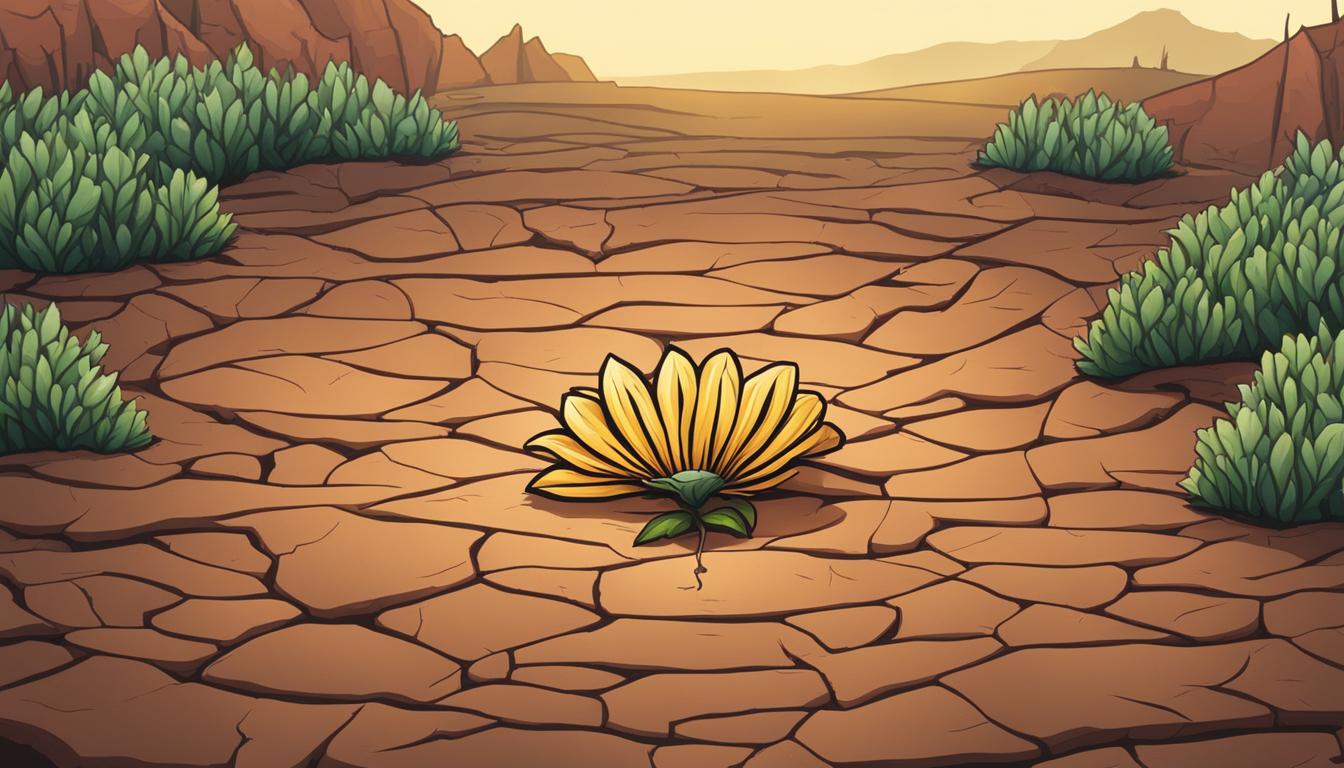
Detecting early signs of plant stress is crucial for ensuring the health and survival of your plants. By being able to identify the symptoms of stress, you can take necessary actions to alleviate the stress and prevent further damage.
Wilting, bleached foliage, blackened leaves, ragged foliage, off-color foliage, dried leaf margins, and burned foliage are some common signs of plant stress.
Key Takeaways:
- Early detection of plant stress is essential for plant health and survival.
- Common signs of plant stress include wilting, bleached foliage, blackened leaves, ragged foliage, off-color foliage, dried leaf margins, and burned foliage.
- Wilting can be caused by lack of soil moisture, excessive soil moisture, high temperature, or the adjustment period for newly transplanted seedlings.
- Bleached foliage may indicate sunburn, especially in newly transplanted or recently moved plants, and gradual exposure to sunlight can help prevent this.
- Blackened leaves can be a result of frost damage, and while the damaged foliage won’t recover, the plants can usually outgrow it.
Wilting as a Sign of Plant Stress
Wilting is a common symptom of plant stress and can be indicative of various underlying factors. It is a visual cue that the plant is experiencing physiological changes and is struggling to maintain its normal functions. Understanding the causes of wilting can help you identify and address plant stress in a timely manner.
One of the main reasons for wilting is a lack of soil moisture. When plants do not receive enough water, their cells lose turgor pressure, causing the leaves and stems to become limp and wilted.
It is important to ensure that your plants receive an adequate supply of water, especially during hot and dry periods. Regularly checking the moisture levels of the soil and providing appropriate irrigation can help prevent wilting due to insufficient soil moisture.
On the other hand, excessive soil moisture can also lead to wilting. When the soil is oversaturated, it becomes waterlogged and limits the availability of oxygen to the plant’s roots.
This oxygen deprivation can cause wilting as the roots are unable to function properly. Proper drainage and avoiding overwatering are essential to prevent wilting caused by excessive soil moisture.
High temperatures and newly transplanted seedlings
In addition to moisture-related issues, high temperatures can also cause wilting in plants. Extreme heat can lead to excessive transpiration, which is the process of water loss through the leaves.
To conserve water, plants may wilt temporarily as a protective mechanism. Keeping plants well-hydrated and providing shade or shelter during intense heat can help alleviate wilting caused by high temperatures.
Furthermore, newly transplanted seedlings are particularly susceptible to wilting. When plants are uprooted and replanted, their root systems need time to establish in the new environment.
During this adjustment period, wilting is common as the roots struggle to absorb water. Providing adequate water and minimizing stress during the transplanting process can help mitigate wilting in newly transplanted seedlings.
| Possible Causes of Wilting | Symptoms |
|---|---|
| Lack of soil moisture | Leaves and stems become limp and wilted |
| Excessive soil moisture | Waterlogged soil leading to root oxygen deprivation and wilting |
| High temperatures | Temporary wilting as a protective mechanism against excessive transpiration |
| Newly transplanted seedlings | Roots struggling to establish in the new environment, resulting in wilting |
Being able to recognize wilting as a sign of plant stress is crucial for maintaining the health and vitality of your plants. By understanding the underlying causes and implementing appropriate measures, such as proper watering techniques and providing shade or shelter, you can help alleviate wilting and promote the overall well-being of your plants.
Bleached Foliage as a Sign of Plant Stress
One of the common signs of plant stress is bleached foliage. This can occur when plants are exposed to direct sunlight, especially for newly transplanted or recently moved plants.
The bleaching is often a result of sunburn and can be prevented by gradually exposing the plants to sunlight over several days. By giving them time to acclimate, the plants can develop a protective layer against sunburn and avoid damage to their foliage.
It is important to note that while bleached foliage may be unsightly, it is usually a temporary issue and most plants will outgrow minor sunburn.
Severe sunburn can cause long-lasting damage and even death to the plants. To prevent sunburn, it is recommended to provide shade or cover for delicate plants during peak sunlight hours, especially in hot and arid regions.
Additionally, it is worth mentioning that certain plant species are more susceptible to sunburn than others. Plants with thin or delicate leaves, such as succulents or young seedlings, are particularly vulnerable.
By selecting appropriate plant varieties for your specific climate and providing them with adequate protection, you can minimize the risk of bleached foliage and ensure the health of your plants.
Plant Species Vulnerability to Sunburn
| Plant Species | Vulnerability to Sunburn |
|---|---|
| Succulents | High |
| Young Seedlings | High |
| Herbs | Moderate |
| Flowering Plants | Low |
Note: The table above provides a general overview of plant species vulnerability to sunburn. Factors such as local climate conditions and individual plant health may also influence their susceptibility to sunburn. It is important to observe and respond to the specific needs of your plants.
Blackened Leaves as a Sign of Plant Stress
Blackened leaves on plants can be a clear indicator of frost damage. When temperatures drop significantly, especially during the early morning hours, the most exposed leaves of plants can suffer from the effects of frost.
These leaves may turn black and appear damaged. It’s important to note that the damaged foliage will not recover, but the plants usually have the ability to outgrow the damage over time.
While it may be tempting to immediately remove the blackened leaves, it is recommended to wait until the threat of frost has passed and new growth appears. This is because the damaged foliage can provide some level of protection to the rest of the plant from further frost damage.
If the blackened leaves become noticeably wilted or diseased, it may be necessary to remove them to prevent disease invasion.
To protect plants from future frost damage, it is essential to take preventive measures. This can include covering plants with blankets or sheets overnight when frost is expected, or creating physical barriers such as fences or walls to shield plants from direct exposure to cold winds.
It’s also important to provide proper watering and ensure that the plants have adequate access to sunlight. Regularly monitoring the weather conditions and taking appropriate actions can help minimize the risk of blackened leaves due to frost damage.
| Frost Damage Prevention Tips | |
|---|---|
| 1. Cover plants with blankets or sheets overnight during frosty weather. | |
| 2. Create physical barriers like fences or walls to protect plants from cold winds. | |
| 3. Provide proper watering and ensure plants have access to sunlight. | |
| 4. Monitor weather conditions and take appropriate actions to prevent frost damage. |
By following these preventative strategies and carefully monitoring and addressing frost damage, gardeners can help their plants recover and thrive, minimizing the impact of blackened leaves as a sign of plant stress.
Ragged Foliage as a Sign of Plant Stress
Ragged foliage can be a telltale sign that plants have been exposed to heavy winds, rain, or hail. While this may primarily be a cosmetic issue, it can also make the plants more vulnerable to diseases. Taking steps to address this stress can promote healthy growth and minimize the risk of disease pathogens invading the plant.
When plants are subjected to strong winds, their foliage can become torn or tattered. Additionally, heavy rainfall or hail can cause physical damage to the leaves, resulting in ragged edges.
While these damaged areas may not directly harm the plant, they can provide entry points for pathogens to invade and cause further damage. By removing the damaged foliage, you can help prevent diseases from taking hold.
To protect your plants from the damaging effects of wind, consider creating physical barriers such as windbreaks or utilizing neighboring plants as natural windbreaks.
These measures can help reduce the impact of strong winds and minimize the occurrence of ragged foliage. Additionally, providing supplemental support, such as stakes or trellises, can help stabilize the plants and prevent excessive movement in windy conditions.
| Causes of Ragged Foliage | Solutions |
|---|---|
| Heavy winds | Create physical barriers or utilize neighboring plants as windbreaks |
| Rain | Provide supplemental support and drainage to prevent waterlogging |
| Hail | Protect plants with covers or move them to a sheltered location during hailstorms |
Overall, while ragged foliage may not pose a significant threat to the health of your plants, it is important to address plant stressors to ensure their optimal growth and well-being.
By taking steps to protect your plants from heavy winds, rain, and hail, you can minimize the occurrence of ragged foliage and reduce the risk of diseases. Regular monitoring and prompt action can go a long way in maintaining the beauty and vitality of your plants.
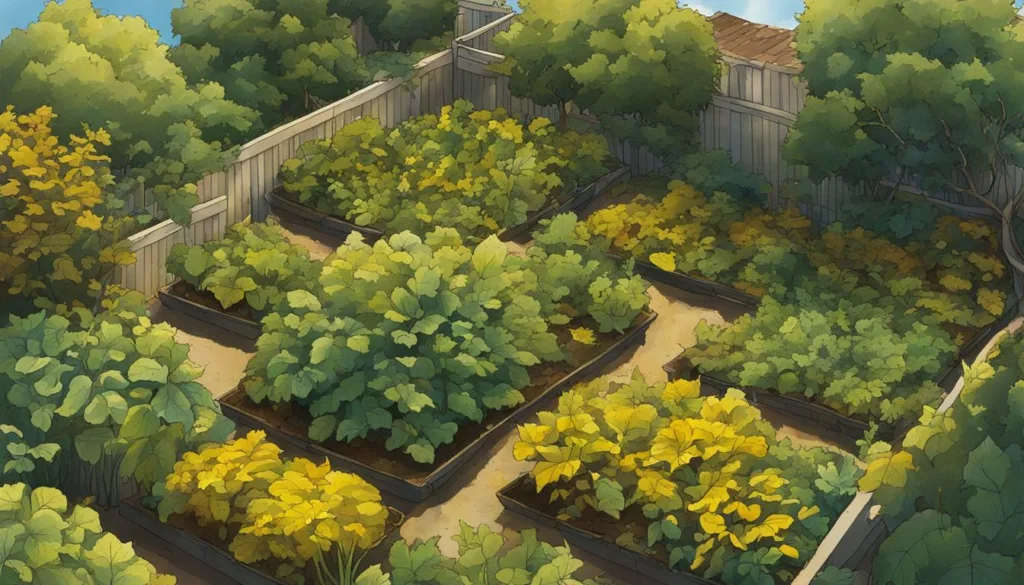
Off-color foliage as a sign of plant stress
Off-color foliage can be a clear indicator of nutrient deficiency in plants. When leaves appear paler than normal, it may indicate a lack of nitrogen, an essential nutrient for plant growth.
Nitrogen deficiency often results in a yellowish or pale green coloration. Another telltale sign of nutrient deficiency is the presence of yellow veins against a green leaf, which is a potential indicator of an iron deficiency.
In some cases, off-color foliage may exhibit a reddish or purplish cast, which can suggest a phosphorus deficiency. Stunted growth can also be a sign of an overall shortage of essential nutrients. It is crucial to address nutrient deficiencies in plants to ensure their healthy development and prevent further stress.
To rectify nutrient deficiencies, organic fertilizers can be used to supply the necessary nutrients. Additionally, it is essential to check the pH of the soil to ensure proper nutrient absorption.
By maintaining optimal nutrient levels, the plant’s foliage can regain its vibrant and healthy color, promoting overall plant vitality and growth.
| Nutrient Deficiency | Signs and Symptoms |
|---|---|
| Nitrogen | Pale or yellowish foliage |
| Iron | Yellow veins against green leaf |
| Phosphorus | Reddish or purplish cast on foliage |
Addressing Off-Color Foliage
- Use organic fertilizers to supply the necessary nutrients.
- Check the pH of the soil to ensure proper nutrient absorption.
- Monitor growth and observe any signs of stunted development.
- Adjust fertilizer application and nutrient levels accordingly.
By addressing off-color foliage promptly, plant enthusiasts can ensure healthier, more vibrant plants, and an overall thriving garden. By providing the necessary nutrients, plants can regain their vigor and resilience, better withstanding stressors and promoting long-term growth and vitality.
Dried Leaf Margins and Burned Foliage as Signs of Plant Stress
When it comes to plant stress, dried leaf margins and burned foliage are common indicators that something is amiss. Dried leaf margins can be a result of fertilizer burn or wind burn, while burned foliage, particularly in a specific area, may suggest damage from herbicide overspray or even animal urine.
To prevent fertilizer burn, it’s crucial to apply fertilizers properly and in the recommended quantities. Over-fertilizing can lead to excess salts in the soil, which can cause the edges of the leaves to dry out and turn brown. It’s important to follow the manufacturer’s instructions and water the plants thoroughly after applying fertilizer to prevent this issue.
Wind burn occurs when plants are exposed to strong winds, which can cause excessive moisture loss and damage to the foliage.
To protect plants from wind burn, consider creating physical barriers such as windbreak fences or planting neighboring shrubs or trees that can act as wind buffers. These measures will help shield the plants from the full force of the wind and reduce stress on the foliage.
If your plants are showing signs of burned foliage in specific areas, it could be due to herbicide overspray or animal urine. Avoid spraying herbicides near desirable plants and take precautions to prevent overspray.
Similarly, if you have pets or wildlife visiting your garden, be mindful of the potential damage caused by urine. To mitigate the effects of burned foliage, gently rinse the affected area with water to dilute the concentration and flush away any potentially harmful substances.
FAQ
How do I detect early signs of plant stress?
Early signs of plant stress can be detected by observing symptoms such as wilting, bleached foliage, blackened leaves, ragged foliage, off-color foliage, dried leaf margins, and burned foliage.
What causes wilting in plants?
Wilting in plants can be caused by factors such as lack of soil moisture, excessive soil moisture, extreme heat, and adjustment to a new environment.
Why do plants develop bleached foliage?
Bleached foliage in plants can be a result of sunburn, especially in newly transplanted or recently moved plants that have been exposed to direct sunlight.
What does blackened leaves indicate in plants?
Blackened leaves in plants can indicate frost damage, especially on the most exposed leaves. It is important to leave the damaged foliage until new growth appears.
Why do plants develop ragged foliage?
Ragged foliage in plants can result from exposure to heavy winds, rain, or hail. While largely cosmetic, it also makes plants more vulnerable to diseases.
What does off-color foliage indicate in plants?
Off-color foliage in plants can be a sign of nutrient deficiency, such as nitrogen deficiency, iron deficiency, or phosphorus deficiency.
What causes dried leaf margins and burned foliage in plants?
Dried leaf margins in plants can indicate fertilizer burn or wind burn, while burned foliage, especially in a specific area, may indicate damage from herbicide overspray or animal urine.

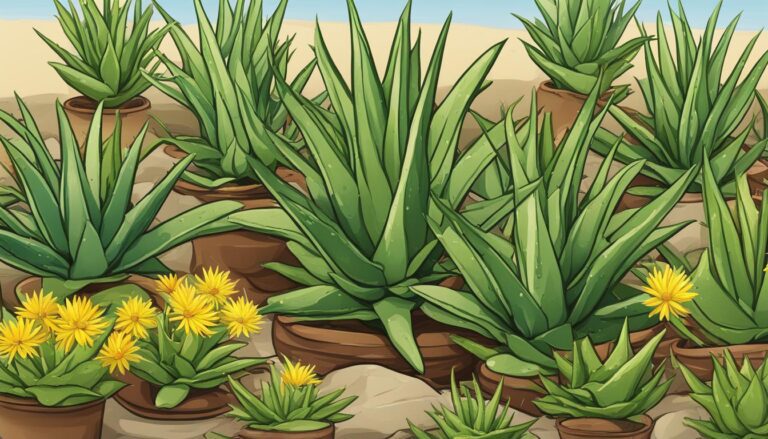

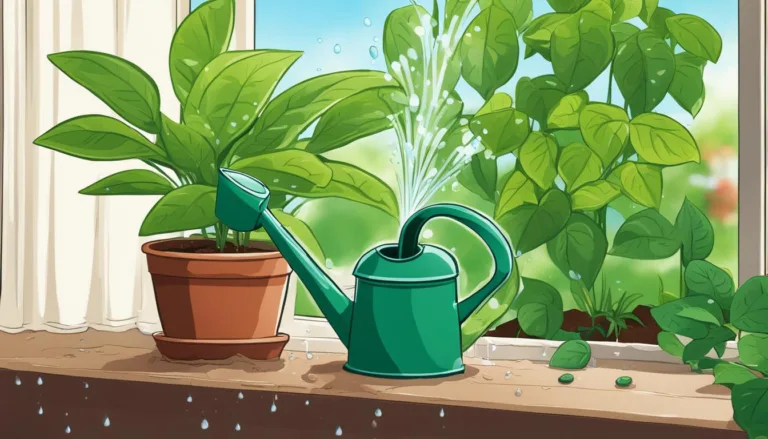
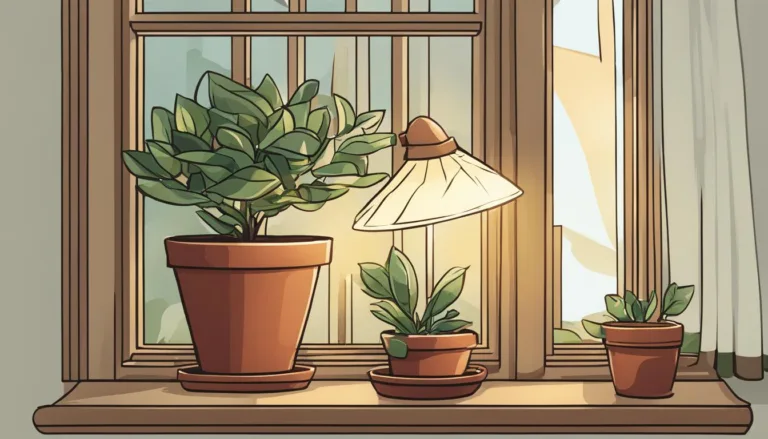
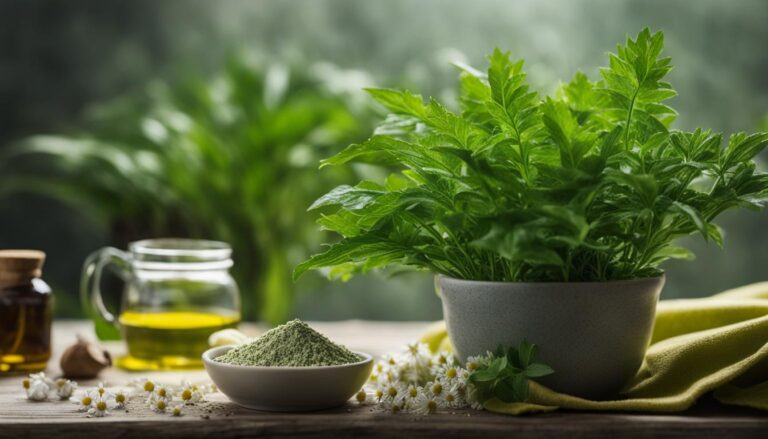

One Comment
Comments are closed.